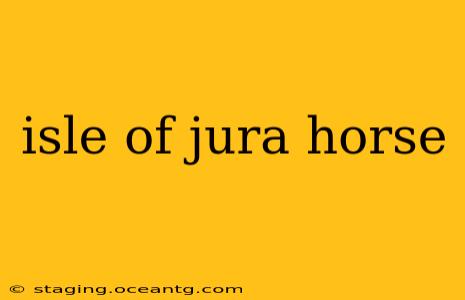The Isle of Jura, a remote Scottish island known for its dramatic landscapes and whisky distillery, also boasts a unique equine heritage. While not a breed in the traditional sense, the ponies of Jura hold a special place in the island's history and culture. This article delves into the characteristics, history, and ongoing conservation efforts surrounding these hardy animals.
What kind of horse is on the Isle of Jura?
The Jura ponies aren't a registered breed like Shetland or Welsh ponies. Instead, they represent a distinct population, shaped by generations of natural selection on the rugged terrain of the island. They're typically small, sturdy ponies, demonstrating the classic characteristics of island ponies: hardiness, resilience, and a remarkable ability to thrive in challenging conditions. Their exact ancestry is a topic of ongoing discussion, likely a blend of various breeds introduced to the island over the centuries, which have then adapted to the unique environment. Genetic studies are ongoing to better define their lineage.
Are Jura ponies rare?
While not officially designated as endangered, the Jura pony population is certainly small and considered a rare and valuable part of Scotland's equine heritage. Their limited numbers, coupled with the isolation of their habitat, make them especially vulnerable to threats like disease and inbreeding. Conservation efforts are crucial to maintaining their genetic diversity and securing their future.
How many Jura ponies are there?
Precise numbers fluctuate, but the population of Jura ponies remains relatively small. The exact count is difficult to maintain due to the wild nature of the ponies and the remote location of the island. Active monitoring and management by conservationists aim to track the population and ensure its long-term viability.
What is special about Jura ponies?
The Jura pony's unique characteristics are a result of centuries of natural selection. Their small size and robust build are ideally suited to the harsh landscape of Jura. They possess exceptional hardiness, capable of surviving the island's challenging weather conditions and foraging for food on the sparse vegetation. Their innate resilience is a testament to their adaptability and underlines their importance as a study in natural selection.
How are Jura ponies managed?
Managing a wild pony population on a remote island presents significant challenges. Conservationists work diligently to monitor the herd's health, manage the population size to avoid overgrazing, and address potential threats to genetic diversity. This often involves careful culling, selective breeding, and health checks to ensure the long-term survival of the ponies.
What is the future of Jura ponies?
The future of the Jura ponies depends on continued conservation efforts and public awareness. Supporting organizations dedicated to preserving the unique genetic heritage of these ponies is crucial. Research into their lineage and genetic makeup will also play an important role in informing management strategies and ensuring their long-term survival. The ongoing work is a testament to the commitment to preserving this valuable part of Scotland's natural and cultural heritage.
Conclusion:
The Isle of Jura's ponies are a fascinating example of adaptation and resilience. Their unique story, interwoven with the island's history and landscape, underscores the importance of conservation efforts to safeguard this precious population for future generations. Their survival stands as a testament to both the power of nature and the dedication of those working to protect these remarkable animals.
